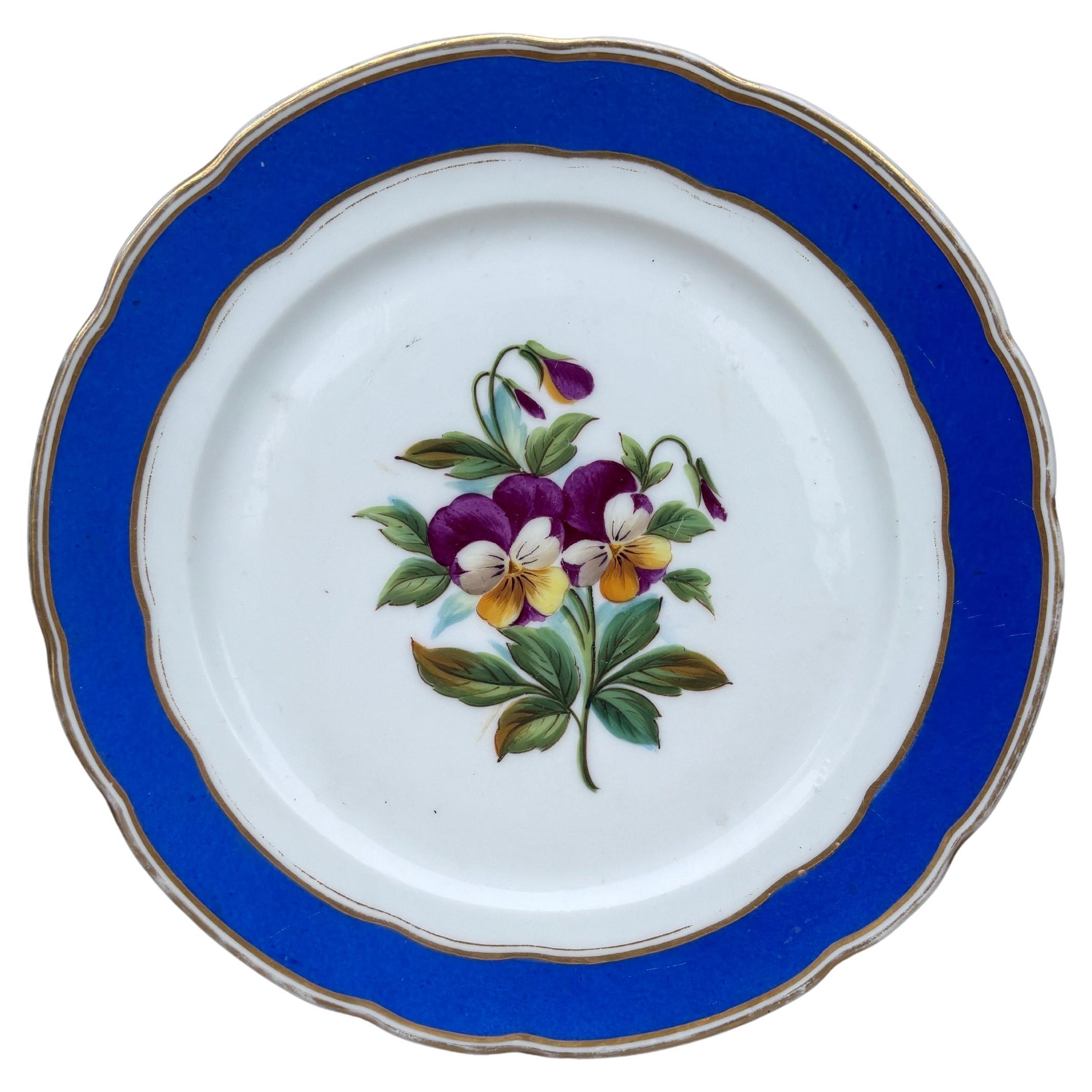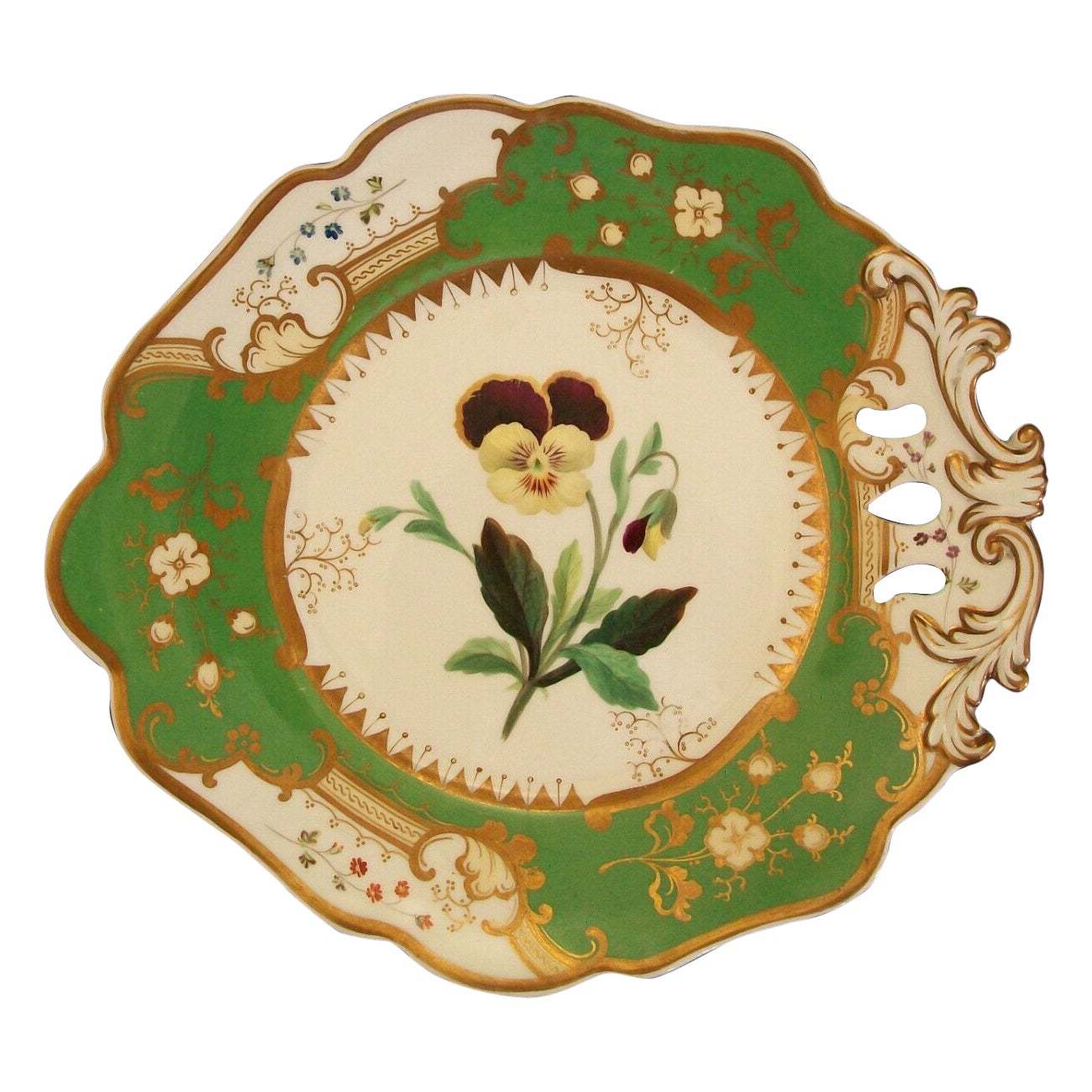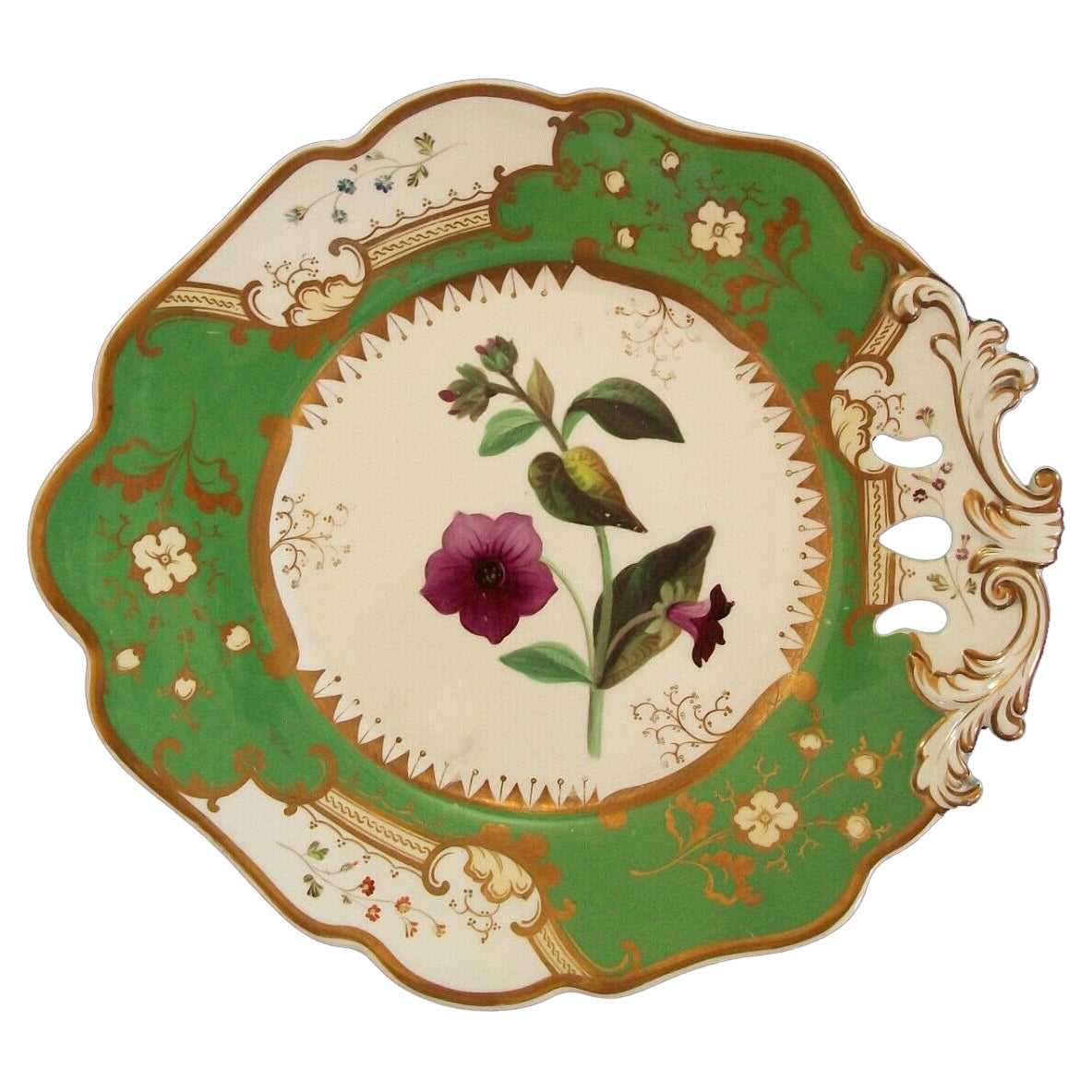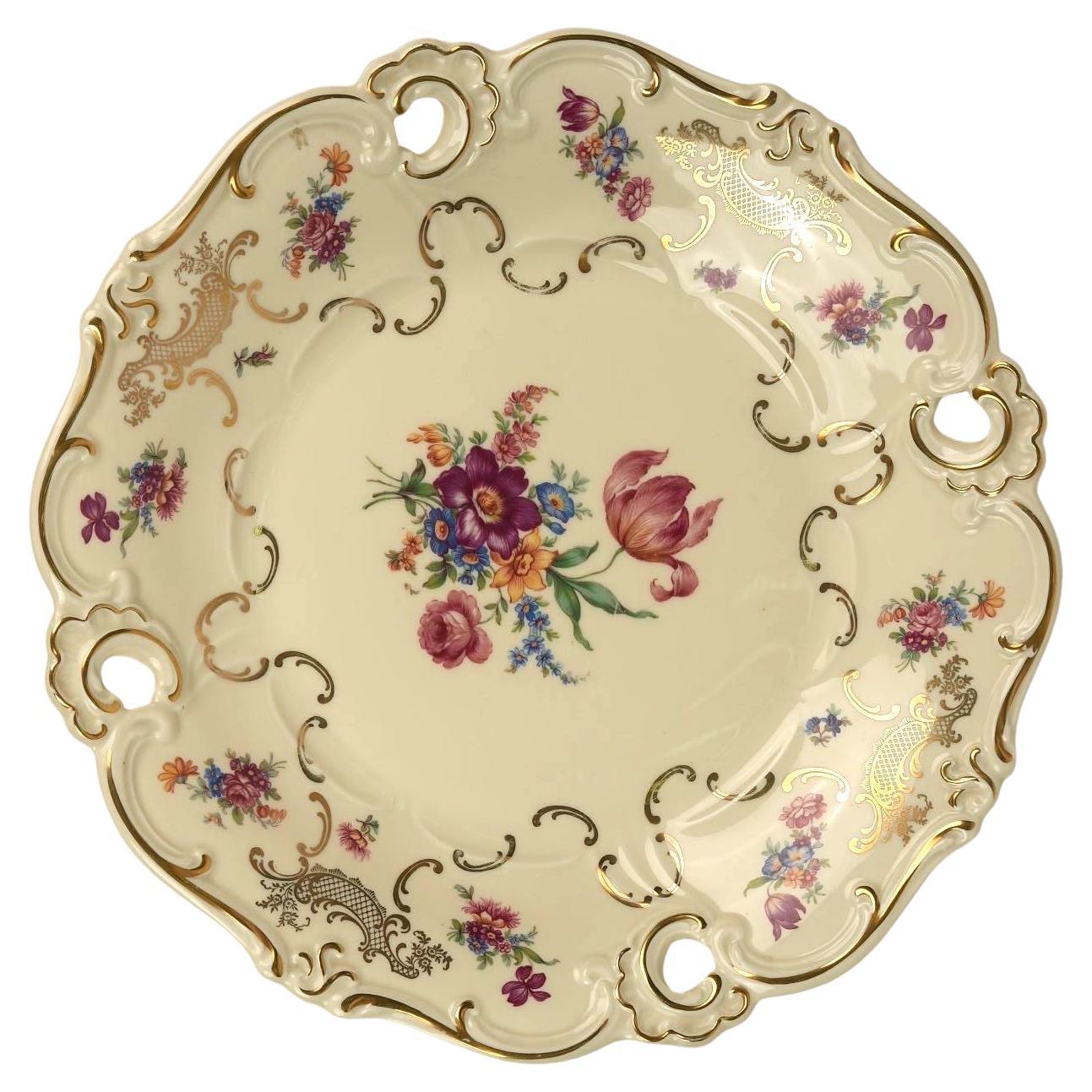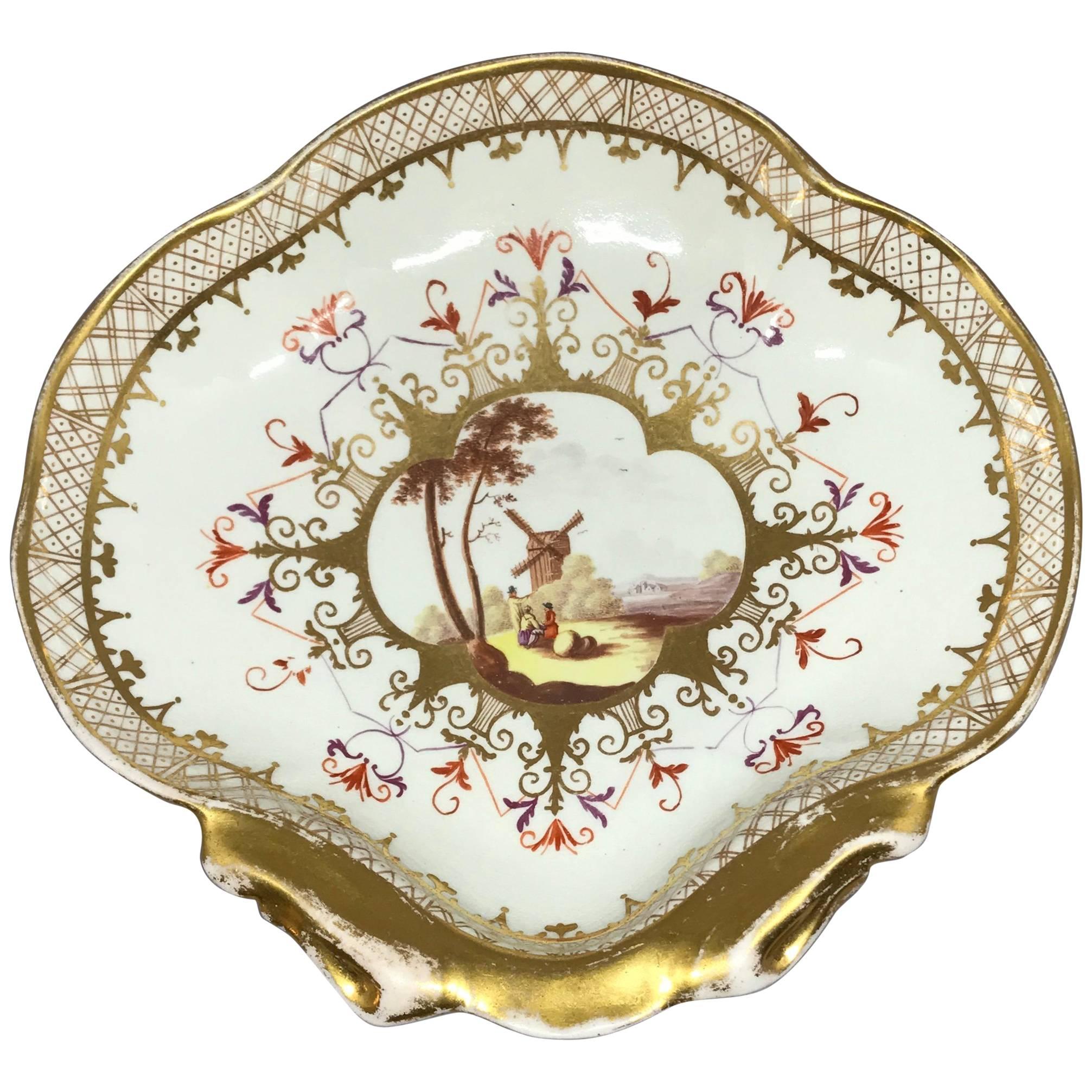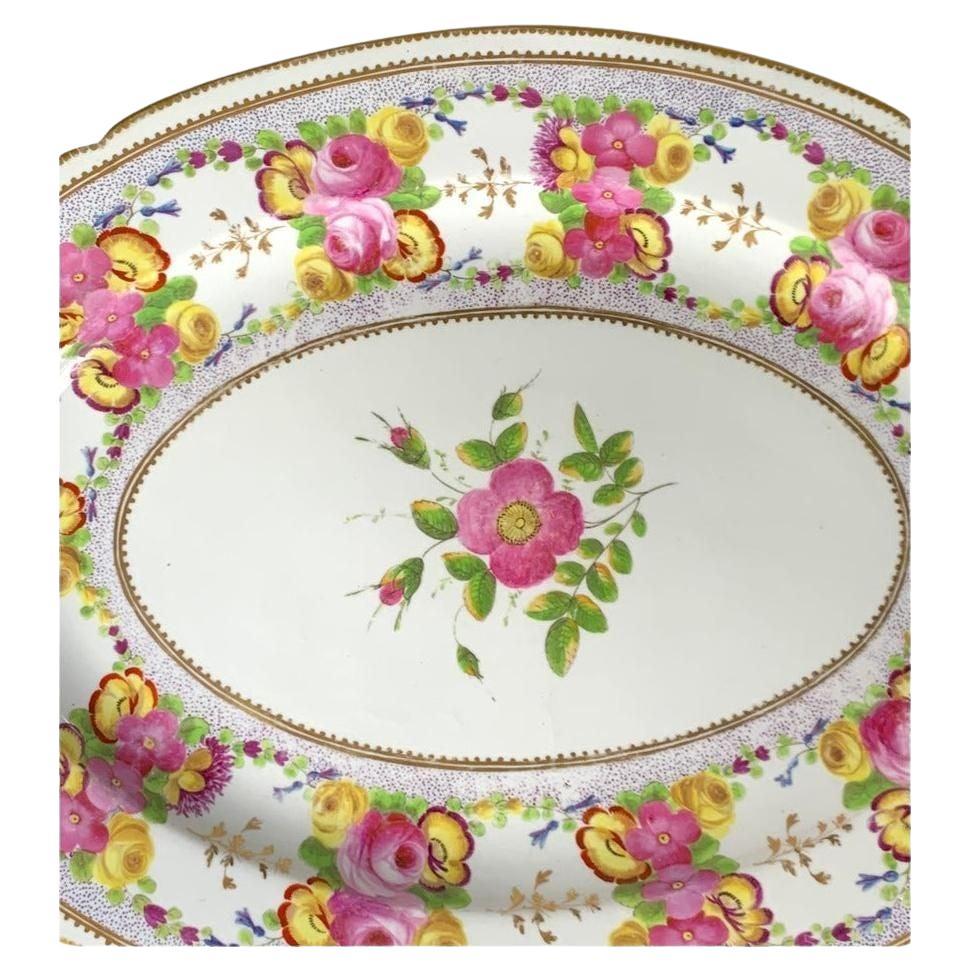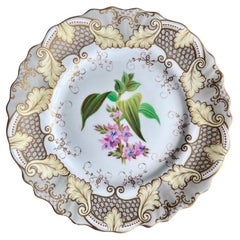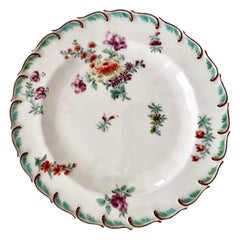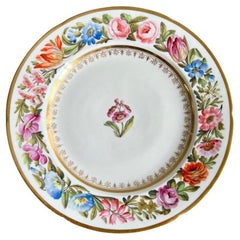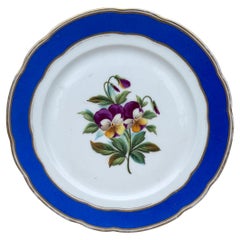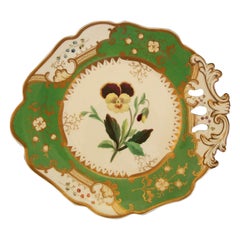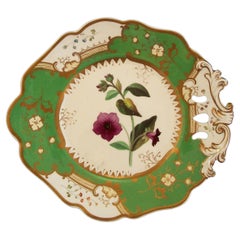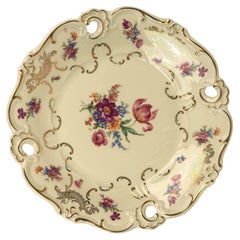Items Similar to Samuel Alcock Porcelain Plate, Maroon Staffordshire Border with Pansy, 1854
Want more images or videos?
Request additional images or videos from the seller
1 of 12
Samuel Alcock Porcelain Plate, Maroon Staffordshire Border with Pansy, 1854
$284
$35520% Off
£217.13
£271.4220% Off
€250.09
€312.6220% Off
CA$397.97
CA$497.4620% Off
A$444.30
A$555.3720% Off
CHF 232.81
CHF 291.0120% Off
MX$5,438.63
MX$6,798.2920% Off
NOK 2,956.63
NOK 3,695.7820% Off
SEK 2,787.72
SEK 3,484.6520% Off
DKK 1,866.47
DKK 2,333.0920% Off
About the Item
This is a striking plate with the popular "Staffordshire" moulding, a deep maroon rim with bold beige and white foliage, and a large hand painted yellow and purple pansy in the centre. The Staffordshire border was so called because the pretzel-like elements symbolise the 7 towns of what is now Stoke-on-Trent, which is where The Potteries were located as the world's prime porcelain hub of its age, including the Samuel Alcock factory. Sometimese these pretzel design elements are pierced; these have their cavities filled in with a fresh lime green colour. This plate has a diamond mark on the back, dating it to 10 April 1854.
Pattern: 3/7590
Year: 1854
Size: 23.2cm (9.15") diameter
Condition: no damage, crazing or repairs, just some surface wear as visible in the pictures.
Provenance: The Murray Pollinger Collection
The Samuel Alcock factory was operative in Staffordshire between 1822 and 1856, after which it was bought by Sir James Duke and Nephews. The factory started as a partnership between the young Samuel Alcock and the older Ralph Stevenson, who provided the factory and capital. Alcock quickly took the factory to great heights, building one of the biggest factories of its time. Alcock jumped on the new Rococo Revival fashion and served a huge new middle class market. The reason we now don't hear much about Samuel Alcock porcelain is that much of it has been mis-identified over the years and attributed to Coalport, Ridgway, Rockingham or others; Alcock did not mark any of his porcelain save a few rare pieces, and the numbering system is difficult to understand. However, the wares are still wide spread and many are of great quality.
This item formed part of the Murray Pollinger Collection of Samuel Alcock Porcelain.
Murray Pollinger was a passionate collector of Samuel Alcock porcelain. He was known as a true gentleman, impeccably dressed, always kind and modest - even some of his porcelain collecting friends had no idea about the size and importance of his collection. From the mid 1980s until shortly before his death in 2022 he collected many thousands of pieces and painstakingly catalogued them. He also went on trips to Staffordshire to discover the history of Samuel Alcock from whatever little documentation has been preserved. Through his painstaking work, Pollinger was able to make sense of the pattern numbering system that was used, and this was a huge step forward in identifying and understanding the porcelain. A website with the results of his research will be made availabe over the course of 2023. While he sold off about half of his collection in 2016, the remaining half is now made available to a new generation of collectors.
Antique British porcelain is never perfect. Kilns were fired on coal in the 1800s, and this meant that china from that period can have some firing specks from flying particles. British makers were also known for their experimentation, and sometimes this resulted in technically imperfect results. Due to the shrinkage in the kiln, items can have small firing lines or develop crazing over time, which should not be seen as damage but as an imperfection of the maker's recipes, probably unknown at the time of making. Items have often been used for many years and can have normal signs of wear, and gilt can have signs of slight disintegration even if never handled. I will reflect any damage, repairs, obvious stress marks, crazing or heavy wear in the item description but some minor scratches, nicks, stains and gilt disintegration can be normal for vintage items and need to be taken into account.
There is widespread confusion on the internet about the difference between chips and nicks, or hairlines and cracks. I will reflect any damage as truthfully as I can, i.e. a nick is a tiny bit of damage smaller than 1mm and a chip is something you can easily see with the eye; a glazing line is a break in the glazing only; hairline is extremely tight and/or superficial and not picked up by the finger; and a crack is obvious both to the eye and the finger. Etcetera - I try to be as accurate as I can and please feel free to ask questions or request more detailed pictures!
- Creator:Samuel Alcock & Co. (Maker)
- Dimensions:Height: 0.75 in (1.91 cm)Diameter: 9.15 in (23.25 cm)
- Style:Rococo Revival (Of the Period)
- Materials and Techniques:
- Place of Origin:
- Period:
- Date of Manufacture:circa 1854
- Condition:Wear consistent with age and use. no damage, crazing or repairs, just some surface wear as visible in the pictures.
- Seller Location:London, GB
- Reference Number:Seller: MP-ALC1171stDibs: LU4805140969022
About the Seller
5.0
Gold Seller
Premium sellers maintaining a 4.3+ rating and 24-hour response times
Established in 2016
1stDibs seller since 2019
226 sales on 1stDibs
- ShippingRetrieving quote...Shipping from: London, United Kingdom
- Return Policy
Authenticity Guarantee
In the unlikely event there’s an issue with an item’s authenticity, contact us within 1 year for a full refund. DetailsMoney-Back Guarantee
If your item is not as described, is damaged in transit, or does not arrive, contact us within 7 days for a full refund. Details24-Hour Cancellation
You have a 24-hour grace period in which to reconsider your purchase, with no questions asked.Vetted Professional Sellers
Our world-class sellers must adhere to strict standards for service and quality, maintaining the integrity of our listings.Price-Match Guarantee
If you find that a seller listed the same item for a lower price elsewhere, we’ll match it.Trusted Global Delivery
Our best-in-class carrier network provides specialized shipping options worldwide, including custom delivery.More From This Seller
View AllSamuel Alcock Plate, Grey and Beige Acanthus Border, Pink Flower, ca 1835
By Samuel Alcock & Co.
Located in London, GB
This is a beautiful plate with a warm grey and beige border of flowing acanthus leaves and pebble design with elaborate gilt, and a beautiful pink flower in the centre.
Pattern: 810...
Category
Antique 1830s English Rococo Revival Porcelain
Materials
Porcelain
$340 Sale Price
20% Off
Free Shipping
Chelsea Plate, Feather Moulded with Flowers, Red Anchor Mark, ca 1755
By Chelsea Porcelain
Located in London, GB
This is a beautiful plate made by Chelsea in circa 1755, which is known as the "Red Anchor" period of the factory.
Chelsea was one of the very early adopters of porcelain in the British china industry. Founded in 1744 the Chelsea pottery was for about 40 years the leading maker of fine chinaware, excelling in their sense of style, perfection and constant innovation and inspiring many following generations of china makers.
The company was started by French silversmith Nicholas Sprimont and you can see the influence of the French style of silverware...
Category
Antique 1750s English George II Dinner Plates
Materials
Porcelain
$916 Sale Price
20% Off
Free Shipping
Samuel Alcock Plate, Pink and Gilt, Landscape Reserves, ca 1855
By Samuel Alcock & Co.
Located in London, GB
This is a beautiful plate in the 8-lobed shape, with a deep pink ground and rich pale yellow and gilt acanthus and shell decoration, three scrolled reserves with exceptionally finely...
Category
Antique 1850s English Rococo Revival Porcelain
Materials
Porcelain
Coalport John Rose Plate, Abundant Flowers, T. Baxter Studio, ca 1805 (2)
By Thomas Baxter, Coalport Porcelain
Located in London, GB
This is a stunning and extremely rare plate made by Coalport around the year 1805, and decorated in the London studio of Thomas Baxter.
We have one more of these plates in stock, pl...
Category
Antique Early 1800s English George III Porcelain
Materials
Porcelain
Derby Kidney Dish, William Quaker Pegg, Scarlet Lychnis & Gentianella, c1814
By Derby, Quaker Pegg At Derby
Located in London, GB
This is a stunning and extremely rare kidney shaped serving dish made by Derby between about 1813 and 1815. The dish is painted with bright red and blue flowers by William Quaker Peg...
Category
Antique 1810s English Regency Porcelain
Materials
Porcelain
$1,800 Sale Price
20% Off
Free Shipping
Worcester Porcelain Plate, Flower Sprays by James Giles, ca 1770
By James Giles, 1st Period Worcester Dr. Wall
Located in London, GB
This is a beautiful large plate made by Worcester in about 1770 in their First or the "Dr Wall" period. The plate has a pleasing slightly lobed rim, a white ground and beautifully pa...
Category
Antique 1770s English George III Porcelain
Materials
Porcelain
You May Also Like
19th Century French porcelain Pansies Plate
Located in Austin, TX
19th Century French Porcelain Pansies Plate signed Leveillé, 12 rue Thiroux"
Called Porcelain of Paris.
9.3 inches diameter.
Category
Antique 1850s French Louis Philippe Dinner Plates
Materials
Porcelain
Coalport, 'Pansy', Antique Botanical Serving Platter, U.K., circa 1830's
By Coalport Porcelain
Located in Chatham, ON
Coalport (Attributed) - 'Pansy' - Antique ceramic single handled botanical serving platter with apple green borders and gilded decoration - featuring a hand painted floral specimen t...
Category
Antique Mid-19th Century British Victorian Platters and Serveware
Materials
Enamel, Gold Leaf
Coalport, 'Lungwort', Antique Botanical Serving Platter, U.K., circa 1830's
By Coalport Porcelain
Located in Chatham, ON
COALPORT (Attributed) - 'Lungwort' - Antique ceramic single handled botanical serving platter with apple green borders and gilded decoration - featuring a hand painted floral specime...
Category
Antique Mid-19th Century British Victorian Platters and Serveware
Materials
Enamel, Gold Leaf
Rosenthal Molière Porcelain Platter with Floral and Gilt Detail
By Rosenthal, Jacob & Co (J. Rosenthal & S. Jacob)
Located in Worcester Park, GB
This vintage Rosenthal Molière porcelain platter is a stunning example of mid-century European fine china that balances ornamental charm with delicate craftsmanship. What makes this ...
Category
Mid-20th Century German Rococo Platters and Serveware
Materials
Porcelain
English Iron Red and Gilt Shell Form Serving Dish After Meissen
By Coalport Porcelain
Located in New York, NY
English iron red and gilt shell form serving dish after Meissen. English chinoiserie shell form dish after Meissen. A rare coal port gilt porcelain sw...
Category
Antique Mid-19th Century English Porcelain
Materials
Porcelain
Antique Coalport Porcelain Platter Hand Painted Floral England Circa 1825
By Coalport Porcelain
Located in Katonah, NY
This antique porcelain platter was made by Coalport in England around 1825.
It is hand-painted with vivid floral sprays in shades of pink, yellow, and purple, centered within an oval...
Category
Antique Early 19th Century Regency Platters and Serveware
Materials
Porcelain
More Ways To Browse
Stained Glass Dress
Antique Pansies
Antique Pansy
Antique Ridgway Porcelain
Coalport China
Coalport Chinese Porcelain
Ridgway Staffordshire
Antique Rockingham
Pierced Porcelain Plates
Coalport White
Coalport Green
Samuel Alcock
Ridgway China
Antique Ridgway Plates
Alcock Porcelain
Coalport Yellow
Rockingham Plate
James Green Nephew
